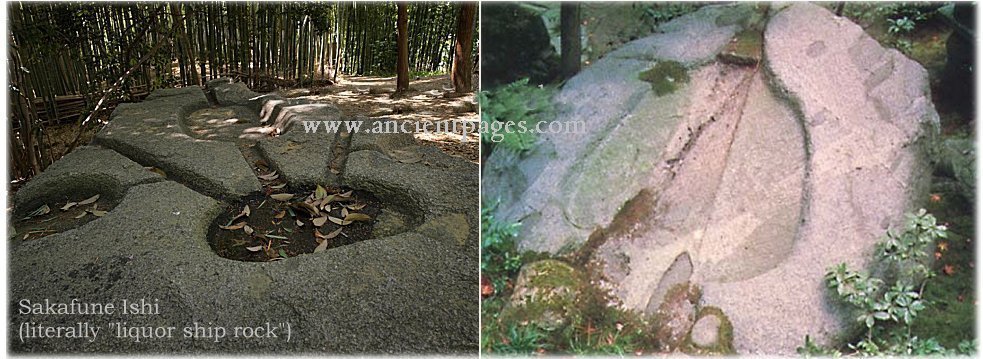Mysterious Object In Asuka – The Place Of ‘Flying Birds’
A. Sutherland - AncientPages.com - Asuka, which means in Ainu, "flying birds" is one of the most historically rich places in Japan.
This remarkable small village, located approximately 20 kilometers south of Nara City, in the Kansai region of Honshu, central Japan, is covered with unusually shaped megaliths, of which many are of titanic dimensions and weights.
So far, no one has been able to shed light on the past of Asuka's stone relics and monuments and their hidden history. They are shrouded in mystery relative to their date of construction and original function.
The most famous of the monuments is ship-like boulder "Masuda no iwafune", located near the top of a hill in the village, in a place Ishi-no-Ho-den".

The "boast stone" is one of most strikingly enigmatic of the Asuka megaliths. One puzzling characteristic is that in places it is rough and unfinished, seemingly entirely like a work of nature, and in other places beautifully cut into right-angled planes.."
"Masuda no Iwafune" does not resemble the style or construction of any other Buddhist monument and represents one of the greatest mysteries of Japan.
Masuda was the name of a lake thought to have been near this stone; hence the translation would literally be "Masuda ship rock".
For the first time, this gigantic boulder was mentioned in Japanese literature of the 8th century.

The so-called 'rock ship of Masuda' - Masuda-no-iwafune - drawing from P.F. von Siebold's volume 1 of his books NIPPON" (1832)"
However, it still represents one of the greatest archaeological puzzles of Japan, because no archaeologist is able to state with certainty how old the Masuda-no-wafune really is or what its original function might have been.
In one of our earlier articles, we wrote about some strange sightings recorded in the sacred texts of The Nihongi. For example in 634 A.D. "a long star seen in the south... which the people called a besom-star", and in 637 A.D. a large "star" was floating from East to West causing a thunder-like noise.
On the 7th day of the second month of Spring, 640 A.D. people saw a "star" that entered the Moon. and another "guest star" entered the Moon on the 9th July 642 A.D.
See also:
Probably The Oldest Star Map Discovered In Stone Chamber Of The Kitora Tomb, Asuka Nara, Japan
First Peoples Of Japan: Ainu Civilization And Its Unknown Origin
Was the Masuda-no-iwafune astronomically oriented? Was it a structure constructed for observations of the sky? A number of questions still remain relative to whether or not the stone was actually used for astronomical observation.
In its upper part, the "Masuda ship rock" has two holes, which were long concealed by pine trees.
The monument is 11 meters long, 8 meters wide and 4.7 meters high and weighs approximately 1000 tons. The upper surface is flat, with a shallow trough and two square holes.
At present, the stone bears lattice-shaped indentations around its base which testify to the process used in flattening the outer surfaces.
There have been countless attempts to explain its origin and purpose, but all these attempts have failed. Researchers have already investigated the rock with ultrasound devices and measured the object with laser scanners only to find nothing.
"The actual purpose" of the great megalith remains a mystery, according to the Asuka Historical Museum
Written by – A. Sutherland AncientPages.com Senior Staff Writer
Copyright © AncientPages.com All rights reserved. This material may not be published, broadcast, rewritten or redistributed in whole or part without the express written permission of AncientPages.com
More From Ancient Pages
-
 Seven Times People Discovered The Americas And How They Got There
Featured Stories | Sep 9, 2022
Seven Times People Discovered The Americas And How They Got There
Featured Stories | Sep 9, 2022 -
 Jack The Ripper Letter Mystery Solved By Forensic Linguist
Archaeology | Feb 1, 2018
Jack The Ripper Letter Mystery Solved By Forensic Linguist
Archaeology | Feb 1, 2018 -
 Denisovan DNA Found In The Genome Of Oldest Human Fossil Discovered In Mongolia
Archaeology | Oct 30, 2020
Denisovan DNA Found In The Genome Of Oldest Human Fossil Discovered In Mongolia
Archaeology | Oct 30, 2020 -
 Migration Of Early Humans Out Of Africa Began Thousands Of Years Earlier Than Previously Thought
Archaeology | Dec 18, 2017
Migration Of Early Humans Out Of Africa Began Thousands Of Years Earlier Than Previously Thought
Archaeology | Dec 18, 2017 -
 Creepy Story Of Lucida Mansi Who Was Obsessed With Her Beauty
Featured Stories | Jul 31, 2019
Creepy Story Of Lucida Mansi Who Was Obsessed With Her Beauty
Featured Stories | Jul 31, 2019 -
 LIDAR Data Helped To Discover Unexplored Region Of Maya World In Campeche, Mexico
Archaeology | Oct 29, 2024
LIDAR Data Helped To Discover Unexplored Region Of Maya World In Campeche, Mexico
Archaeology | Oct 29, 2024 -
 Cup Of Jamshid – Holy Grail Of Ancient Persia Offered Immortality And Visions Of The Future
Featured Stories | Jan 16, 2019
Cup Of Jamshid – Holy Grail Of Ancient Persia Offered Immortality And Visions Of The Future
Featured Stories | Jan 16, 2019 -
 The Aztec Sun Stone And Medusa Reveal An Intriguing Connection – Surprising Discovery – Part 1
Ancient Mysteries | Jul 30, 2018
The Aztec Sun Stone And Medusa Reveal An Intriguing Connection – Surprising Discovery – Part 1
Ancient Mysteries | Jul 30, 2018 -
 First People To Enter The Americas Brought Their Dogs With Them
Archaeology | Jan 29, 2021
First People To Enter The Americas Brought Their Dogs With Them
Archaeology | Jan 29, 2021 -
 Viking Burial Rituals: High Ancient Funeral Pyre Reflected High Social Status
Ancient Traditions And Customs | Mar 13, 2017
Viking Burial Rituals: High Ancient Funeral Pyre Reflected High Social Status
Ancient Traditions And Customs | Mar 13, 2017 -
 Marriage And Divorce In Ancient Egypt Were Different But Uncomplicated
Ancient History Facts | Dec 12, 2018
Marriage And Divorce In Ancient Egypt Were Different But Uncomplicated
Ancient History Facts | Dec 12, 2018 -
 Mysterious Massive 3,800-Year-Old Structure And Passageway Found In The Jezreel Valley, Israel
Archaeology | Aug 23, 2023
Mysterious Massive 3,800-Year-Old Structure And Passageway Found In The Jezreel Valley, Israel
Archaeology | Aug 23, 2023 -
 Why Were Neolithic Houses Always Built Counterclockwise?
Archaeology | Jan 13, 2020
Why Were Neolithic Houses Always Built Counterclockwise?
Archaeology | Jan 13, 2020 -
 Scientists Argue Over The Mysterious Void Discovered Inside The Great Pyramid Of Giza
Archaeology | Nov 8, 2017
Scientists Argue Over The Mysterious Void Discovered Inside The Great Pyramid Of Giza
Archaeology | Nov 8, 2017 -
 Swiss Farmer Discovered Roman Coins Among Cherry Trees
Archaeology | Nov 22, 2015
Swiss Farmer Discovered Roman Coins Among Cherry Trees
Archaeology | Nov 22, 2015 -
 Mysterious Tiahuanaco Empire Established By The Sons Of The Sun – An Unknown Chapter Of Prehistory
Ancient Mysteries | Oct 30, 2018
Mysterious Tiahuanaco Empire Established By The Sons Of The Sun – An Unknown Chapter Of Prehistory
Ancient Mysteries | Oct 30, 2018 -
 New Dating Of Intriguing Cave Art Reveals History Of Puerto Rican People
Archaeology | Oct 19, 2023
New Dating Of Intriguing Cave Art Reveals History Of Puerto Rican People
Archaeology | Oct 19, 2023 -
 Traces Of Early Humans Discovered In Southern Iran
Archaeology | Sep 25, 2019
Traces Of Early Humans Discovered In Southern Iran
Archaeology | Sep 25, 2019 -
 Megalithic Cemetery With 49-50M Long Tombs Was Accidentally Found In Poland
Archaeology | Mar 10, 2021
Megalithic Cemetery With 49-50M Long Tombs Was Accidentally Found In Poland
Archaeology | Mar 10, 2021 -
 The Maya Produced Rubber 3,000 Years Before Goodyear
Ancient History Facts | Mar 12, 2016
The Maya Produced Rubber 3,000 Years Before Goodyear
Ancient History Facts | Mar 12, 2016




